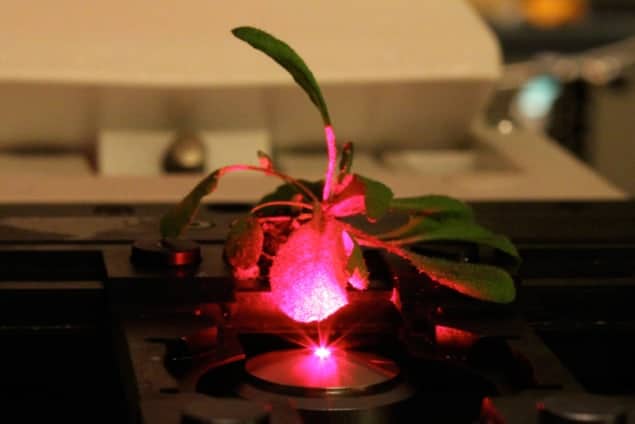
Nanoparticles could increase the amount of solar energy captured by plants by as much as 30%. That is the conclusion of researchers at the Massachusetts Institute of Technology (MIT), who have shown that plants with semiconducting carbon nanotubes in their leaves can better convert energy from sunlight into electrical current.
The team believes that the discovery could be exploited in a new field dubbed plant “nanobionics”, whereby nanoparticles could enhance natural functions in ordinary plants and also be used to create artificial plant-like systems that grow and repair themselves using sunlight and water. Potential applications include biochemical detectors for monitoring pollutants in the environment and perhaps even new technologies that would help increase crop yields.
“Plants provide us with food and fuel, and even the oxygen we breathe, but they have been little used in technology applications until now,” says team member Juan Pablo Giraldo. “We are talking about a new field at the interface between nanotechnology and plant biology, which we have called plant nanobionics.”
Measuring electron flow
Led by Michael Strano, the team used two techniques to measure electron flow in plant leaves and chloroplasts in the lab. The first relied on measuring the changes in colour of a dye that intercepts electrons between the photosystems in chloroplasts extracted from plants. The second is based on monitoring changes in chlorophyll fluorescence in extracted chloroplasts and leaves. Chloroplasts are organelles inside a plant cell that use chlorophyll to capture and store the energy from solar radiation.
According to the MIT team, the nanotubes appear to enhance the amount of light absorbed by chlorophyll at wavelengths that are normally only weakly captured by plants. This includes green light as well as the ultraviolet and near-infrared parts of the electromagnetic spectrum. The result is that the nanoparticle-treated plant leaves can produce as much as 30% more photocurrent than non-treated plants.
The researchers also found that nanotubes combined with polymer nanoparticles containing ceria (a rare-earth metal oxide) act as “antioxidants”, and dramatically reduce the number of damaging oxygen radicals in extracted chloroplasts – something that could also help increase photosynthetic activity.
Self-repairing artificial plant-like systems
“Being able to enhance chloroplast photosynthesis with nanoparticles could allow us to develop artificial plant-like systems that would be powered by solar energy and be able to repair themselves like real plants,” says Giraldo. “Both these and the nanoparticle-augmented ordinary plants, might, for example, be used as biochemical detectors for monitoring pollutants, such as nitric oxide, in the environment. They might even be able to detect dangerous chemicals and gases, depending on the type of nanoparticle incorporated.”
The team says that it would now like to better understand how carbon nanotubes capture and transfer light energy to the photosynthetic machinery in plant chloroplasts. “The ultimate goal is to find out whether assembling chloroplasts with nanoparticles such as carbon nanotubes can help increase the amount of chemical fuels (such as glucose) that plants produce,” Giraldo explains. “Such studies will take our technology to a new level of applications, such as increasing crop yields or algae biofuel production.
“Ideally, we need remote-detection instruments that allow us to image in real time the near-infrared fluorescence changes of carbon nanotubes in plants under real-life conditions,” he adds.
The research is described in Nature Materials.
- This article first appeared on nanotechweb.org



